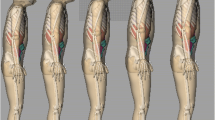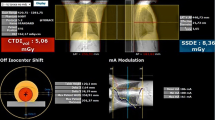Abstract
Background
Previously published dose reference level (DRL) values may no longer be applicable due to technological advancement. New Australian legislation recommends that local DRLs (LDRLs) are established to monitor the performance and dose of CT examinations.
Objective
To present paediatric DRL values, in a new clinically applicable format, based on weight and referenced to both the 16-cm- and 32-cm-diameter CT dosimetry phantom sizes. To demonstrate local experience in reporting DRLs in this manner and compare these LDRL values with other published paediatric DRL data.
Materials and methods
A retrospective statistical analysis of dose indices was performed on 1382 CT examinations. The mean CT dose index volume (CTDIvol) and dose length product (DLP) are reported from display data on the Toshiba Aquilion 64 scanner (Toshiba Medical, Tochigi, Japan).
Results
LDRLs were compiled based on weight and the two CT dosimetry reference phantoms for torso examinations, and for the 16-cm-diameter CT dosimetry phantom for head examinations.
Conclusion
LDRLs were compiled for the Royal Children’s Hospital (RCH) Brisbane for reference by clinicians during routine clinical practice. These are compared to other published DRLs as a quality measure.
Similar content being viewed by others
References
Brenner DJ, Hall EJ (2007) Computed tomography—an increasing source of radiation exposure. N Engl J Med 357:2277–2284
Colang JE, Killion JB, Vano E (2007) Patient dose from CT: a literature review. Radiol Technol 79:17–26
Slovis TL, Berdon WE, Hall EJ (2003) Section 1. Effects of radiation on children. In: Kuhn JP, Slovis TL, Haller JO (eds) Caffey’s pediatric diagnostic imaging, 10th edn. Pennsylvania, Mosby, pp 1–12
Brenner DJ (2002) Estimating cancer risks from pediatric CT: going from the qualitative to the quantitative. Pediatr Radiol 32:228–231
Brenner D, Elliston C, Hall E et al (2001) Estimated risks of radiation-induced fatal cancer from pediatric CT. AJR 176:289–296
Vock P (2005) CT dose reduction in children. Eur Radiol 15:2330–2340
Australian Radiation Protection and Nuclear Safety Agency (2008) Radiation Protection Series No. 14, Code of Practice: Radiation Protection in the Medical Applications of Ionizing Radiation. Available via http://www.arpansa.gov.au/pubs/rps/rps14.pdf Accessed 21 June 2008
Australian Radiation Protection and Nuclear Safety Agency (2008) Radiation Protection Series No. 14.1, Safety Guide: Radiation Protection in Diagnostic and Interventional Radiology. Available via http://www.arpansa.gov.au/pubs/rps/rps14_1.pdf Accessed 25 May 2008
Shrimpton PC, Hillier MC, Lewis MA et al (2006) National survey of doses from CT in the UK: 2003. Br J Radiol 79:968–980
Verdun FR, Gutierrez D, Vader JP et al (2008) CT radiation dose in children: a survey to establish age-based diagnostic reference levels in Switzerland. Eur Radiol 18:1980–1986
Shrimpton PC, Wall BF (2000) Reference doses for paediatric computed tomography. Radiat Prot Dosimetry 90:249–252
Frush DP, Soden B, Frush KS et al (2002) Improved pediatric multidetector body CT using a size-based color-coded format. AJR 18:721–726
Singh S, Kalra M, Moore MA et al (2009) Dose reduction and compliance with pediatric CT protocols adapted to patient size, clinical indication, and number of prior studies. Radiology 252:200–208
AuntMinnie.com staff writers (2009) ARRS study: Child’s body shape can reduce CT dose. Available at http://www.auntminnie.com/print/print.asp?sec=sup&sub=ped&pag=dis&ItemId=855 Accessed 13 June 2009
McCollough C, Cody D, Edyvean S et al (2008) The measurement, reporting, and management of radiation dose in CT. AAPM report No. 96. American Association of Physicists in Medicine, Maryland, pp 1–28
Miyazaki O, Horiuchi T, Masaki H et al (2008) Estimation of adaptive computed tomography dose index based on body weight in pediatric patients. Radiat Med 26:98–103
Nagel HD, Galanski M, Hidajat N et al (2002) Radiation exposure in computed tomography: fundamentals, influencing parameters, dose assessment, optimisation, scanner data, terminology, 4th edn. CTB Publications, Hamburg
European Commission (1999) European guidelines on quality criteria for computed tomography. Report EUR 16262 EN. Office for Official Publications of the European Communities, Brussels. Available at http://www.drs.dk/guidelines/ct/quality/index.htm Accessed 3 August 2006
Tinning K, Acworth J (2007) Make your best guess: an updated method for paediatric weight estimation in emergencies. Emerg Med Australas 19:528–534
Croarkin C, Tobias P (2006) Engineering statistics handbook, 2nd version. National Institute of Standards and Technology Available at http://www.itl.nist.gov/div898/handbook/ Accessed 9 May 2009
Chapple CL, Willis S, Frame J (2002) Effective dose in paediatric computed tomography. Phys Med Biol 47:107–115
Strauss KJ, Goske MJ, Frush DP et al (2009) Image gently vendor summit: working together for better estimates of pediatric radiation dose from CT. AJR 192:1169–1175
Thomas KE, Wang B (2008) Age-specific effective doses for pediatric MSCT examinations at a large children’s hospital using DLP conversion coefficients: a simple estimation method. Pediatr Radiol 38:645–656
Alliance for radiation safety in pediatric imaging. Available at http://www.pedrad.org/associations/5364/ig/ Accessed: October 14 2008
Goske K, Applegate K, Boylan J et al (2008) Image Gently (SM): a national education and communication campaign in radiology using the science of social marketing. J Am Coll Radiol 5:1200–1205
Brisse H, Aubert B (2009) CT exposure from pediatric MDCT: results from the 2007–2008 SFIPP/IRSN survey. J Radiol 90:207–215
Shrimpton PC (2004) Assessment of patient dose in CT. Report NRPB-PE/1/2004. NRPB, Chilton. Also published as Appendix C of the 2004 CT quality criteria (MSCT, 2004) at http://www.msct.eu/CT_Quality_Criteria.htm Accessed December 2006
Shrimpton PC, Hillier MC, Lewis MA et al (2005) National survey of doses from CT in the UK—2003 review. Report NRPB—W67, NRPB Publications. Available at http://www.hpa.org.uk/radiation/publications/index.htm
Author information
Authors and Affiliations
Corresponding author
Rights and permissions
About this article
Cite this article
Watson, D.J., Coakley, K.S. Paediatric CT reference doses based on weight and CT dosimetry phantom size: local experience using a 64-slice CT scanner. Pediatr Radiol 40, 693–703 (2010). https://doi.org/10.1007/s00247-009-1469-1
Received:
Revised:
Accepted:
Published:
Issue Date:
DOI: https://doi.org/10.1007/s00247-009-1469-1




